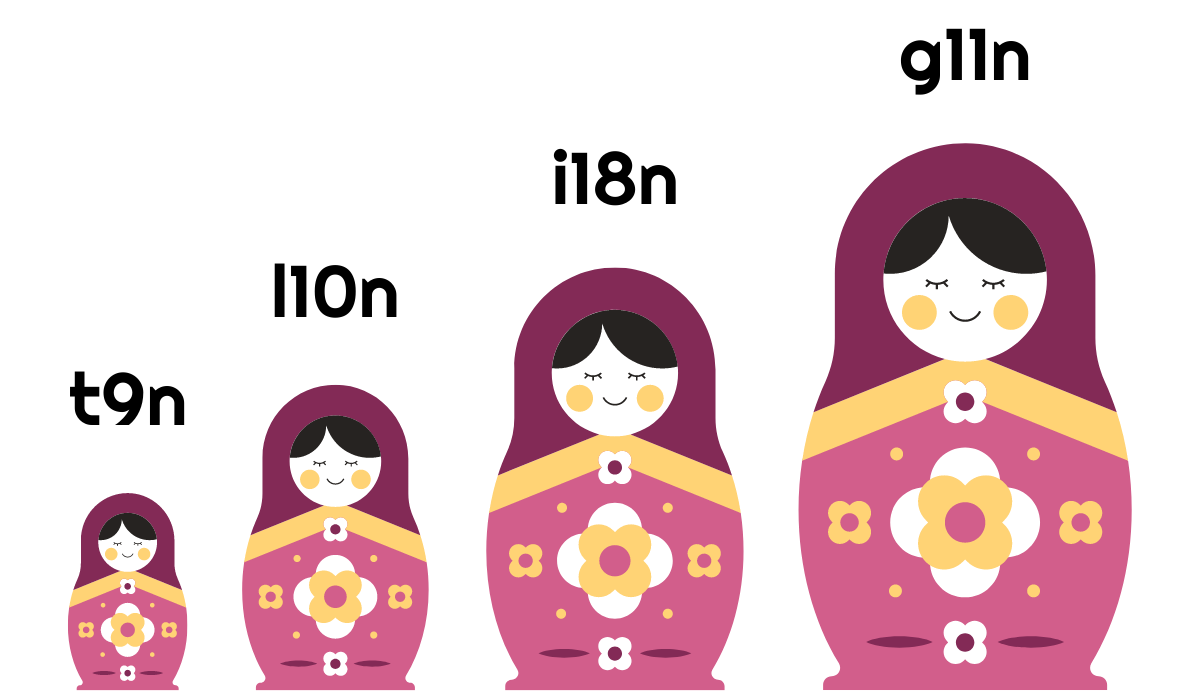
In the tech world, you may come across a few confusing acronyms. Those number-based words are called numeronyms. They are often used to abbreviate long words. Just take the first and last letter and count the letters in between.
Let's dive into the explanations for each abbreviation:
- t9n = translation
- l10n = localization (🇬🇧 localisation)
- i18n = internationalization (🇬🇧 internationalisation)
- g11n = globalization (🇬🇧 globalisation)
At first sight, you could think that they all mean more or less the same thing, but it is not the case. Let’s start with the easy one.
What is t9n?
Translation is simply the process of converting text from one language (source language) to another (target language). It makes a crucial part of the localization process. Translation plays a vital role in making content accessible and relatable to diverse audiences worldwide.
What is l10n?
Localization refers to the adaptation of a product, app, or content to meet the language, cultural and other requirements of a specific target market (a "locale") to be available to your target audience.
The process of software localization can take three different forms:
Waterfall Localization - Quick time-to-market in your source language because localization begins after all the features had been implemented and the product is released.
Agile Localization - Increased productivity and flexibility in your localization workflow. Localization is incorporated into an agile product development cycle. It is accomplished in short work cycles (sprints).
Continuous Localization - Improved version of Agile localization: continuous localization is an ongoing cycle. Get feedback from all stakeholders faster and reduce the risk of localization errors by launching in many markets at the same time.
What is i18n?
Internationalization is not the same as software localization.
“Internationalization is the process of designing and developing a product or application so that it may be localized for different cultures, regions, and languages. To put it another way, internationalization is what makes localization possible.”
I18n is the first step in making software global. Software developers are usually in charge of internationalization, whereas translators are in charge of localization. Before you start working on any localization tasks, make sure you finish any internationalization work first.
Internationalization entails a variety of tasks, including:
Text length - When designing software, developers can account for the differences in length between languages to guarantee that translated text is visible in software interfaces, even if it is longer than the original. Text expansion or contraction occurs when the target language (the language you translate into) occupies more space than the source language.
Currencies symbols and numbers - Each language has its own system for writing numbers and currency, and software should be able to handle all of them.
Date and time formats - Different countries use different date and time formats, therefore software should account for all of them.
Character encoding - The internationalization should be able to handle a wide range of scripts, even some that aren't Latin.
Language direction - It's critical that software intended for languages that read from right to left (such as Arabic, Hebrew, or Persian) can handle text oriented in any direction.
What is g11n?
Globalization is the process of adapting and selling software products to an international audience. It is related to your company's overall strategy for growing business on a global scale. Let’s be honest - designing and creating software that easily responds to language requirements for the entire world could be a big challenge.
Conclusion
To wrap up, the tech world is filled with puzzling numeronyms, which are number-based abbreviations for long words. Take, for example, t9n, l10n, i18n, and g11n, which represent translation, localization, internationalization, and globalization, respectively. While they may appear similar at first glance, each abbreviation carries its own meaning and plays a vital role in making software accessible to diverse audiences.
About Tolgee
If you're seeking a comprehensive solution for your software localization needs, Tolgee offers a powerful combination of i18n capabilities and an efficient localization platform.
I18n open-source tool and localization platform Tolgee is transforming the software localization process with a novel technique that intends to reduce time and effort for everyone involved in the process, including developers and translators. Tolgee software localization platform is a free and open-source online tool that helps software developers localize their products for international markets. Sign up and try it out for free!
Join the growing community of developers and translators who have embraced Tolgee to simplify their localization workflows and deliver exceptional multilingual experiences to users worldwide.

